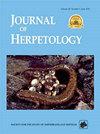雌性和雄性生产温度下里维斯龟(Mauremys reevesii)的缪勒氏管发育和退化
IF 0.8
4区 生物学
Q3 ZOOLOGY
引用次数: 0
摘要
摘要。里维斯龟(又称中华三疣塘龟、Mauremys reevesii)表现出温度依赖性性别决定(TSD)。最近的研究报告对李氏鳖进行了基因组测序,并描述了李氏鳖正常的胚胎和性腺发育模式,这使李氏鳖有望成为研究TSD的模型。然而,该物种的其他生殖器官(如Müllerian导管)的发育尚未得到描述。Müllerian导管是一种管状结构,主要形成于雌雄动物胚胎发育过程中的肾中叶。雌性的缪勒管进一步发育成生殖道,而雄性的缪勒管通常会退化。在这项研究中,我们研究了在雌性(FPT;318℃)和雄性(MPT;268℃)温度条件下,M. reevesii胚胎发育后半期的Müllerian导管发育和退化情况。组织学分析表明,Müllerian导管在MPT条件下的温度敏感期结束时首次出现衰退迹象,并在孵化前阶段(第24期)显著衰退。M.reevesii的Müllerian导管的发育和退化遵循了小鼠和鸡研究中报道的一般轨迹。退行的时间与另一种TSD龟--池塘滑龟(Trachemys scripta)的报道一致。我们的研究为TSD物种生殖器官的比较研究和阐明导致性分化的机制奠定了基础。本文章由计算机程序翻译,如有差异,请以英文原文为准。
Müllerian Duct Development and Regression in Reeves' Turtles, Mauremys reevesii, Under Female- and Male-Producing Temperatures
Abstract. Reeves' Turtles (also known as Chinese Three-Keeled Pond Turtles, Mauremys reevesii) exhibit temperature-dependent sex determination (TSD). Recent studies reported genome sequencing and described normal embryonic and gonadal developmental patterns in M. reevesii, making them a promising model for studying TSD. Nevertheless, development of other reproductive organs, such as the Müllerian duct, has not been described in this species. The Müllerian duct is a tubular structure that primarily forms in mesonephros during embryogenesis in both sexes. While the Müllerian duct further develops into the reproductive tract in females, it typically regresses in males. In this study, we investigated the development and regression of the Müllerian duct in M. reevesii during the latter half of embryogenesis under female- (FPT; 318C) and male-producing temperatures (MPT; 268C). Histological analysis revealed that the Müllerian duct showed the first sign of regression at the end of the temperature-sensitive period under MPT and significantly regressed at the prehatching stage (stage 24). Development and regression of the Müllerian duct in M. reevesii followed general trajectories reported in mouse and chicken studies. Timing of regression was consistent with reports in another TSD turtle, Pond Sliders (Trachemys scripta). Our study provides a basis for comparative studies of reproductive organs in TSD species and for elucidating mechanisms leading to sexual differentiation.
求助全文
通过发布文献求助,成功后即可免费获取论文全文。
去求助
来源期刊

Journal of Herpetology
生物-动物学
CiteScore
1.60
自引率
0.00%
发文量
45
审稿时长
6 months
期刊介绍:
The Journal of Herpetology accepts manuscripts on all aspects on the biology of amphibians and reptiles including their behavior, conservation, ecology, morphology, physiology, and systematics, as well as herpetological education. We encourage authors to submit manuscripts that are data-driven and rigorous tests of hypotheses, or provide thorough descriptions of novel taxa (living or fossil). Topics may address theoretical issues in a thoughtful, quantitative way. Reviews and policy papers that provide new insight on the herpetological sciences are also welcome, but they must be more than simple literature reviews. These papers must have a central focus that propose a new argument for understanding a concept or a new approach for answering a question or solving a problem. Focus sections that combine papers on related topics are normally determined by the Editors. Publication in the Long-Term Perspectives section is by invitation only. Papers on captive breeding, new techniques or sampling methods, anecdotal or isolated natural history observations, geographic range extensions, and essays should be submitted to our sister journal, Herpetological Review.
 求助内容:
求助内容: 应助结果提醒方式:
应助结果提醒方式:


